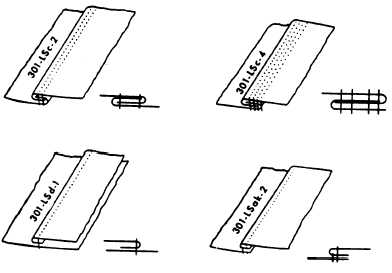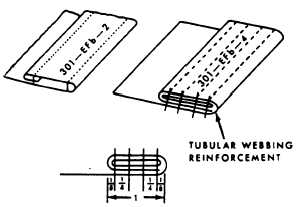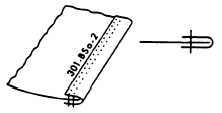Figure 10-34.—Lapped seam.
2. The LSd-1 seam, as shown in figure 10-34,
is used in sewing pockets or patches. Also, use
the seam to patch small holes.
3. The LSak-2 seam, as shown in figure 10-34,
is used for finishing seams of covers for shop
equipment.
Class BS, Bound Seams.— BSa-2 seams are
made by folding binding strips or tapes over the
edges of the material to reinforce and finish the
edges. Use the BSa-2 seam, as shown in figure
10-35, to bind the edges of tool aprons,
reinforcement panels etc. Most soundproofing is
bound with 3/4-inch tape using the BSa-2 seam.
CLASS OF STITCHING.— You form class
EF (edge finishing) stitching by using the edge of
a single ply of material to make the hem. The
EFb-4 stitching, as shown in figure 10-36, is made
by folding the edge back twice, thus turning the
cut edge inside the second fold to prevent fraying
and to reinforce the hem. The hem may also
include a piece of reinforcing tape, plain or
tubular webbing for adding strength. All seams
Figure 10-35.—Bound seam.
Figure 10-36.—Edge finishing stitching.
and stitches pictured are used in the survival
equipment shop for modification and repair work
on the parachute canopy, pack, seat, and back
pads, or for making covers and bags for aircraft,
shop equipment, and tools.
Appropriate Spacing of
Machine-sewn Seams
The following rules will help you to space
correctly more than one line of stitching and to
place a seam the correct distance from the edge:
1. Sew regular binding tape one-sixteenth of
an inch from the selvage edge of the tape.
2. Sew heavier tapes from one-sixteenth to
one-eighth inch from the edge. Sew the raw ends
of the tapes one-fourth inch from the raw edge.
10-27





